BAROQUE
ART
Art of the 17th Century - The age of Mannerism. Baroque derives from the
Portuguese word “barocco” – an irregular shaped pearl. Baroque style, originating in Rome, Italy, was
actively encouraged by the Roman Catholic Church to communicate religious themes in direct and emotional
participation. The council of Trent (1563), the Church’s response to the Protestant’s Reformation, further
encouraged the creation of visual art to illustrate the message of the scriptures to the laity. The Protestant
Churches were totally opposed to the patronage of visual arts.
Religious commissions provided the main source
of income for artists, however the nobility and aristocracy also promoted the baroque style who enjoyed its
dramatic capacity to impress visitors with grand opulence and to express “triumph, power and control”. Pomp
and grandeur were important elements of the Baroque artistic movement, as can be seen when Louis XIV (the “Sun
King”) said, "I am grandeur incarnate".
By the end of the 18th century, art critics
were using the word in a derogatory sense - to be gaudy, over-sentimental or of poor taste. Later those
opinions would not last.
Italian Artists
ANNIBALE
CARACCI (1560-1609)
Early Italian Baroque artist. Caracci’s interest in glimmering colors to paint
objects with mistier edges owes influence by the Venetian painters like Titian.
“The Triumph of
Bacchus and Ariadne” (1597)
Fresco (Palazzo Farnese Gallery, Rome, Italy)
Celling fresco depicts love scene of pagan gods (as described by the Roman poet
Ovid). Took 7 years. New twist: the subjects look human, not Gods.

MICHELANGELO
MERISI DA CARAVAGGIO (c. 1571-1610)
Known as “Caravaggio”. Italian artist who combined a realistic observation of
the human state with a dramatic use of lighting, both ‘stage-like’ and yet natural (“radical
naturalism”).
“The Incredulity
of Saint Thomas” (1602)
Oil on Canvas (Sanssouci, Potsdam, Germany)
According to St John's Gospel, Thomas the
Apostle missed one of Jesus's appearances to the
Apostles after His resurrection, and said "Unless I see the nail marks in his hands and put my finger where
the nails were, and put my hand into his side, I will not believe it." (John 20:25). A week later Jesus
appeared and told Thomas to touch Him and stop doubting. Then Jesus said, "Because you have seen me, you have
believed; blessed are those who have not seen and yet have believed."
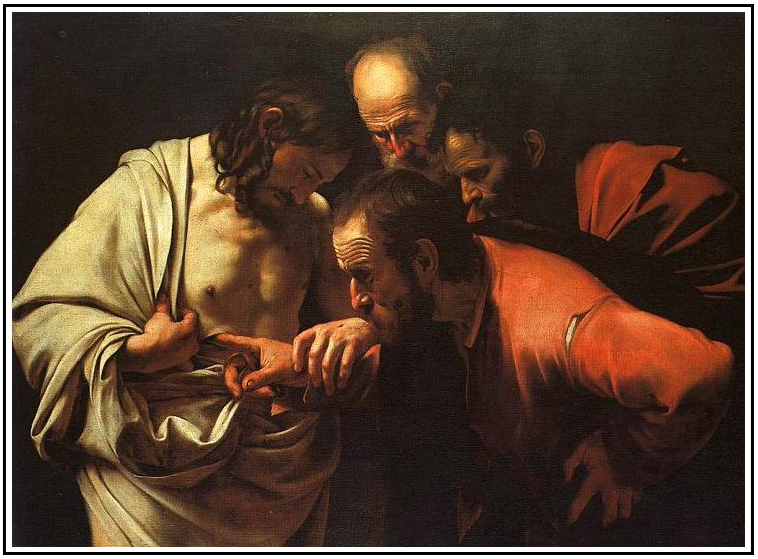
“The Calling of
St. Matthew” (1600)
Oil on Canvas (Church of St Louis of the French, Rome, Italy)
Depicts the moment at which Jesus Christ inspires Matthew to follow
him (Matthew 9:9).

“David with the
Head of Goliath” (1610)
Oil on Canvas (Galleria Borghese, Rome, Italy)
The sword in David’s hand carries an abbreviated inscription H-AS OS; interpreted as
an abbreviation of the Latin phrase Humilitas occidit superbian (“humility kills pride”). One interpretation
of ‘David with the Head of Goliath’ is that of a double self-portrait: the young Caravaggio as ‘David’, who
lived too wild and riotous, now holds the head of the adult Caravaggio – the symbol of irresponsible youth
destroying one’s life as a mature adult.
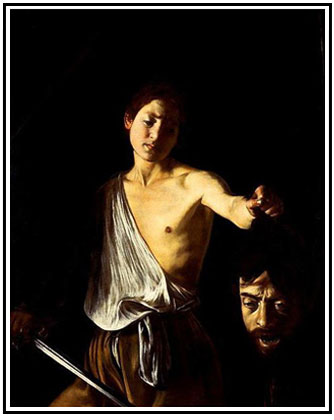
GIANIORENZO
BERNINI (1598-1680)
Bernini was an Italian sculptor and prominent architect. He is credited with
creating the Baroque style of sculpture.
"Apollo and
Daphne" (1622-1625)
Marble (Balleria Borghese, Rome)
"Apollo and Daphne" depicts the climax of the story of Daphne and Phoebus
in Ovid's Metamorphoses. In Greek mytholody,
when Cassandra (daughter of King Priam and Queen Hecuba of Troy) angers Apollo by refusing him, he alters her
gift of prophecy so that, while true, no one would believe her. The Trojans disregard Cassandra's warnings
about the wooden horse left on the beach by the Greeks, resulting in Troy's downfall.

“Ecstasy of Saint
Teressa” (1648-1652)
Marble (Church of Saint Maria, Rome, Italy)
Masterpiece of the High Roman Baroque period. It pictures Roman
Catholic mystic Saint Teresa of
Avila.
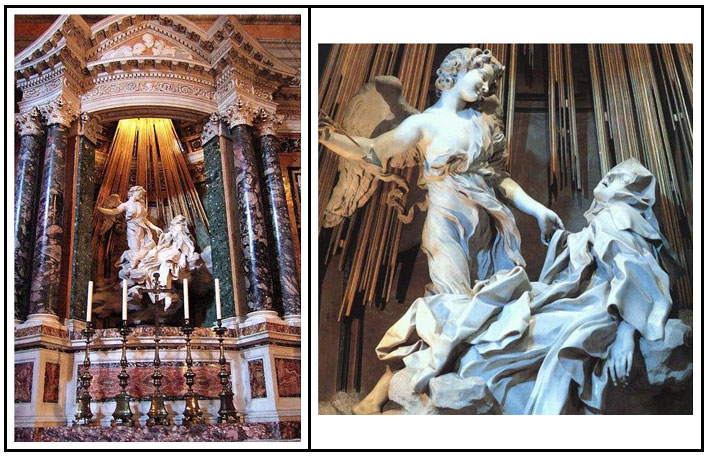
Spanish Artists
DIEGO
VELAZQUEZ (1599-1660)
Velazquez was a major painter of the Spanish Golden Age. Painter to King
Phillip IV. Characteristics: skill in depicting humanity; cleaver usage of space; lots of ‘suggestive’ and
‘mysterious’ things. Influenced by Caravaggio’s natural look.
“Las
Manitas” (1656)
Oil on Canvas (Museo del Prado, Madrid, Spain)
Complex and enigmatic composition. Raises questions about reality and illusion
and the role between the viewer and the painting’s subjects (the young Margaret Theresa of Spain and her
entourage).
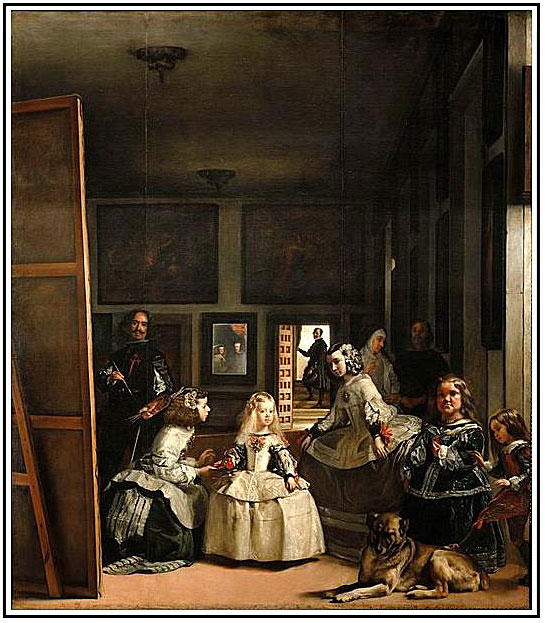
“The Triumph of
Bacchus” (1629)
Oil on Canvas (Museo del Prado, Madrid, Spain)
Popularly known as Los Borrachos (The Drunks). Bacchus surrounded by
drunks.
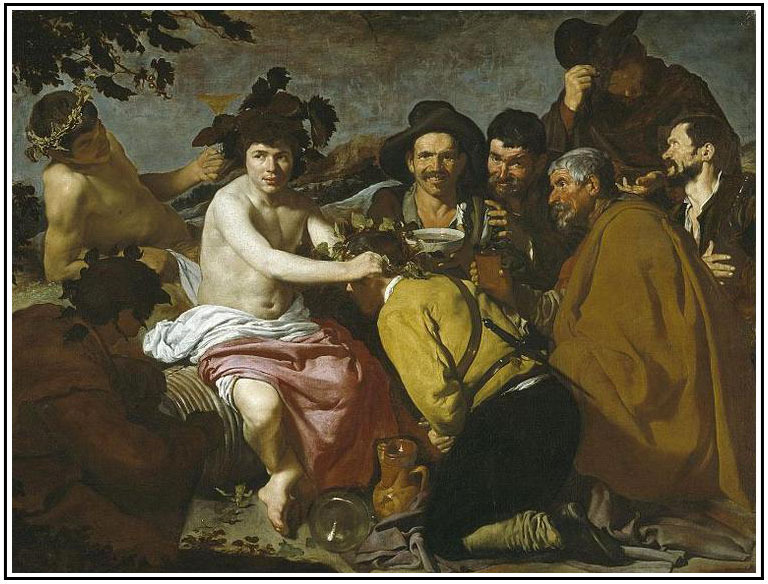
“Portrait of
Innocent X” (c. 1650)
Oil on Canvas (Doria Pamphilj Gallery, Rome, Italy)
Many artists and art critics consider Portrait of Innocent X the finest portrait ever
created.
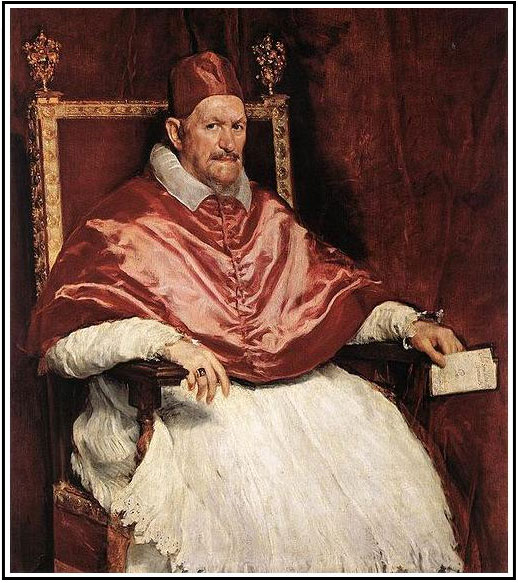
Flemish
Artists
PETER PAUL RUBENS
(1577-1640)
Flemish painter who employed an extravagant baroque style that emphasized movement,
color and sensuality.
“The Elevation of
the Cross” (1611)
Oil on Canvas (Cathedral of Our Lady, Antwerp, Belgium)
First great work. Skill in expressing the aliveness of the human
anatomy.
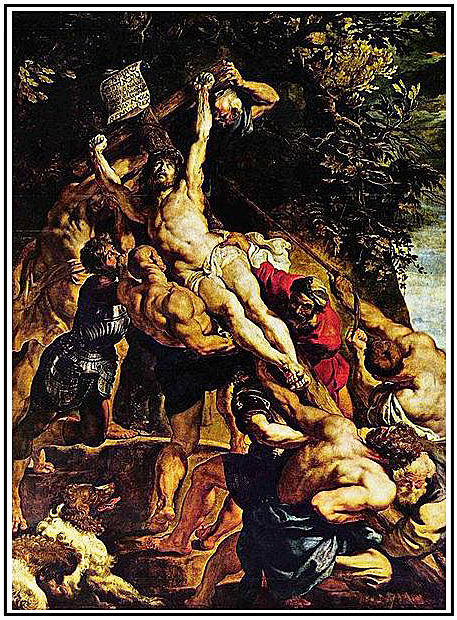
“Rape of the
Daughters of Leucippus” (c. 1618)
Oil on Canvas (Alte Pinakothek, Munich, Germany)
Depicts the mythical twin brothers, mortal Castor and the immortal Pollux, abducting
Phoebe and Hilaeira, priestess daughters of Leucippus.
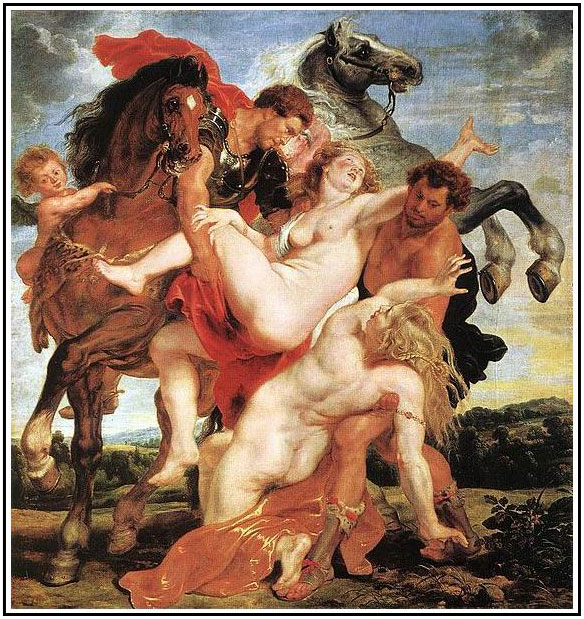
“The Lion
Hunt” (1621)
Oil on Canvas (National Gallery, London, England)
Rubens proudly discussed this painting in a 1621 letter: "I have almost finished a
large picture, entirely by my hand, and in my opinion one of my best, representing a Lion Hunt, with the figures
life-sized."
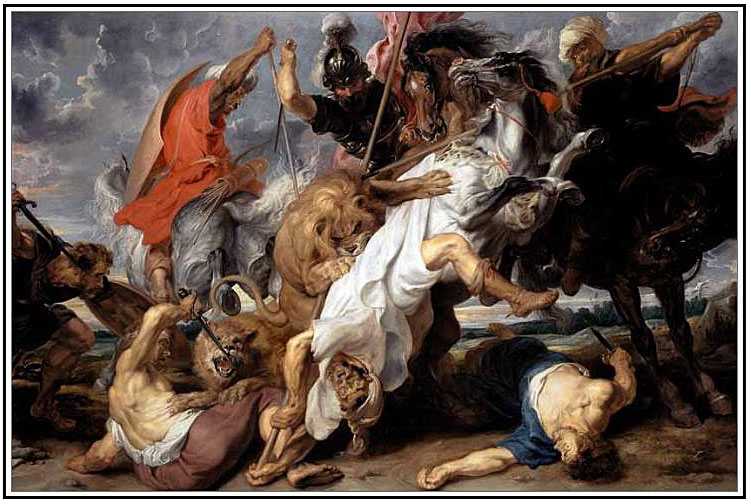
“Self
Portrait”
Oil on Canvas (Kunsthistorisches Museum,
Vienna Austria)
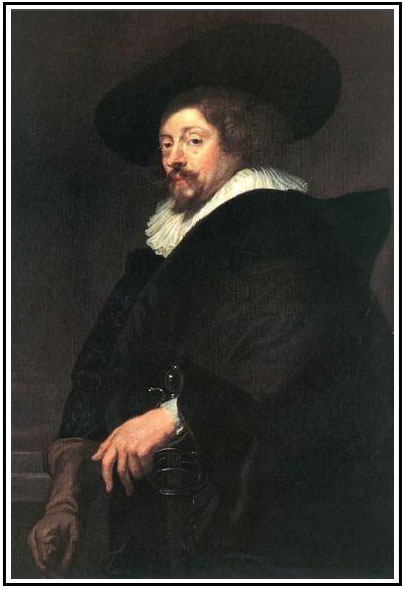
Dutch
Artists
In Protestant Holland life was different in
comparison to the Flanders visual artist. The Protestant Churches were totally opposed to the patronage of
visual art. They interpreted such art as graven and forbidden by scripture. To make a living, Dutch
artists focused on portraits, landscapes, seascapes, still-life or anything the artist considered celibate. In the
end it proved to be a liberating development. Portraiture became very popular among the thriving Holland
business community. A clear Baroque identity developed among the Dutch painters.
FRANS
HALS (c. 1582-1666)
Dutch Golden Age painter. Notable for his loose ‘painterly’ brushwork (visible
brushstrokes); famous for his portraits in capturing the humanity and personality of the subjects. Influenced
by Caracci and Caravaggio.
“Laughing
Cavalier” (1624)
Oil on Canvas (Wallace Collection, London, England)
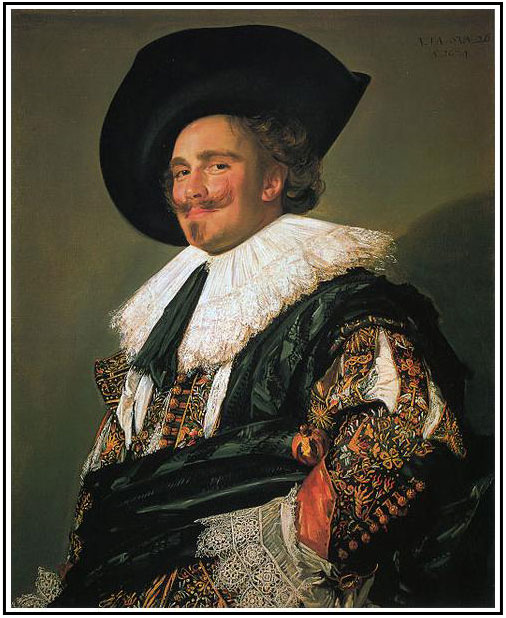
REMBRANT HARMENSZOON VAN RIJN
(1606-1669)
Dutch painter and etcher. Generally considered the world’s greatest portrait
artist. Keen ability to capture the person behind the face. He mastered the skill in depicting several
people together. Also a master of drawings and etchings.

“The Man with the Golden Helmet” (c. 1650)
Oil on Canvas (Gemaldegalerie,
Berlin)
The self-absorbed expression on the
man's face has been interpreted as a 'sleeping Mars' - symbolizing silent weapons, and thus peace. The Rembrandt
Research Project currently considers the work to have originated from "someone in his circle".
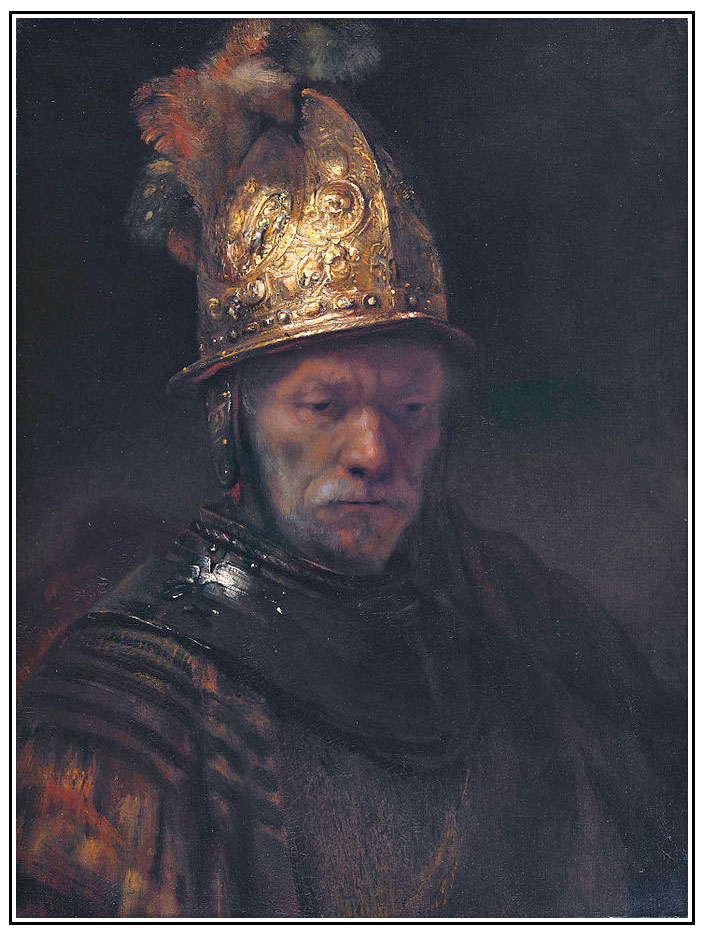
“The Sampling
Officials” (1662)
Oil on Canvas (Rijksmuseum, Amsterdam)
Considered Rembrandt’s “last great collective portrait”. The painting appears on the
packaging of Dutch Masters cigars. The men are drapers who were elected to assess the quality of cloth that weavers
offered for sale to members of their guild.
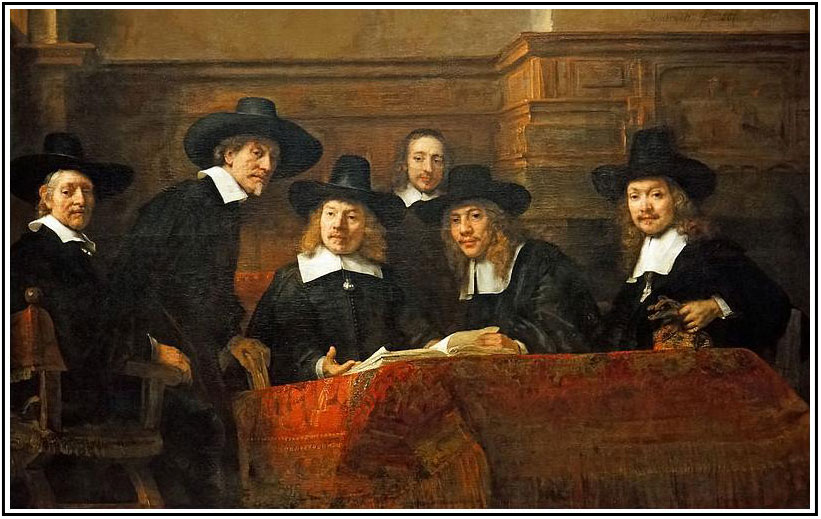
“Conspiracy of Claudius
Civilis” (1662)
Originally the largest painting by Rembrant (~15’). The painting was
commissioned by the Amsterdam city council for the Town Hall. It was returned back to Rembrandt, who may have
never been paid. Rembrandt cut down the painting to a quarter of the original size to be sold. The
painting’s scene depicts an episode from the Batavian rebellion (70AD), where the one-eyed chieftain Claudius
Civilis bounds the whole assembly of “bolder spirits of the lower class” with “barbarous rites and strange forms of
oath.” (the painting was most likely returned due to Rembrandt’s incongruous crown and a King without a
“consultative, republican attitude”).

JOHNANNES (JAN)
VERMEER (1632-1675)
Dutch painter who specialized in domestic interior scenes of real people doing real
things in real places. Calm distribution of light; superb arrangement of space. Some critics claim that
Vermeer is not a Baroque artist in the strictest sense.
“The
Milkmaid” (c. 1658)
Oil on Canvas (Rijksmuseum, Amsterdam)
The Rijksmuseum regards “The Milkmaid” as “unquestionably one of the museum’s finest
attractions”.
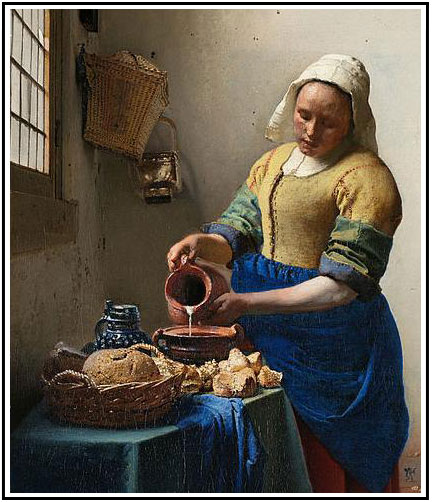
“View of
Delft” (1661)
Oil on Canvas (Mauritshuis, The Hague, Netherlands)
Painting of Vermeer’s hometown.
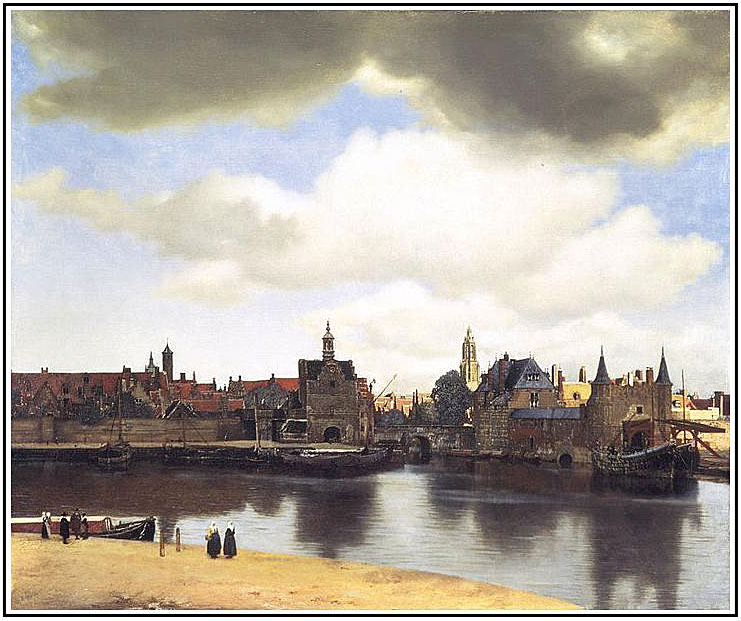
“Girl with a
Pearl Earring” (c.1665)
Oil on Canvas (Mauritshuis, The Hague, Netherlands)
Vermeer’s masterwork.
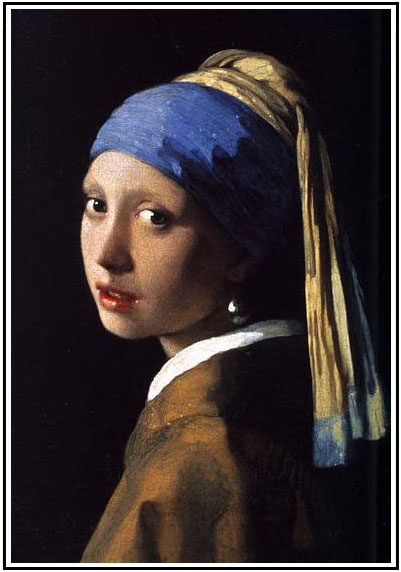
z
| 



















